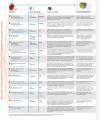A Comprehensive Review of the Genetics of Dyslipidemias and Risk of Atherosclerotic Cardiovascular Disease
- PMID: 40004987
- PMCID: PMC11858766
- DOI: 10.3390/nu17040659
A Comprehensive Review of the Genetics of Dyslipidemias and Risk of Atherosclerotic Cardiovascular Disease
Abstract
Dyslipidemias are often diagnosed based on an individual's lipid panel that may or may not include Lp(a) or apoB. But these values alone omit key information that can underestimate risk and misdiagnose disease, which leads to imprecise medical therapies that reduce efficacy with unnecessary adverse events. For example, knowing whether an individual's dyslipidemia is monogenic can granularly inform risk and create opportunities for precision therapeutics. This review explores the canonical and non-canonical causes of dyslipidemias and how they impact atherosclerotic cardiovascular disease (ASCVD) risk. This review emphasizes the multitude of genetic causes that cause primary hypercholesterolemia, hypertriglyceridemia, and low or elevated high-density lipoprotein (HDL)-cholesterol levels. Within each of these sections, this review will explore the evidence linking these genetic conditions with ASCVD risk. Where applicable, this review will summarize approved therapies for a particular genetic condition.
Keywords: Lp(a); atherosclerotic cardiovascular disease; dyslipidemia; genetics; hyperalphalipoproteinemia; hypercholesterolemia; hypertriglyceridemia; hypoalphalipoproteinemia.
Conflict of interest statement
The authors are employees of GB Healthwatch and GBinsight who developed and markets clinical genetic testing for dyslipidemias.
Figures


Similar articles
-
Alirocumab therapy in individuals with type 2 diabetes mellitus and atherosclerotic cardiovascular disease: analysis of the ODYSSEY DM-DYSLIPIDEMIA and DM-INSULIN studies.Cardiovasc Diabetol. 2019 Nov 9;18(1):149. doi: 10.1186/s12933-019-0951-9. Cardiovasc Diabetol. 2019. PMID: 31706300 Free PMC article.
-
Management of triglycerides, non-high density lipoprotein cholesterol and high density lipoprotein cholesterol.Indian Heart J. 2024 Mar;76 Suppl 1(Suppl 1):S58-S64. doi: 10.1016/j.ihj.2023.11.004. Epub 2023 Nov 17. Indian Heart J. 2024. PMID: 37979723 Free PMC article. Review.
-
The High-Density Lipoprotein Puzzle: Why Classic Epidemiology, Genetic Epidemiology, and Clinical Trials Conflict?Arterioscler Thromb Vasc Biol. 2016 May;36(5):777-82. doi: 10.1161/ATVBAHA.116.307024. Epub 2016 Mar 10. Arterioscler Thromb Vasc Biol. 2016. PMID: 26966281 Review.
-
The Forgotten Lipids: Triglycerides, Remnant Cholesterol, and Atherosclerotic Cardiovascular Disease Risk.Endocr Rev. 2019 Apr 1;40(2):537-557. doi: 10.1210/er.2018-00184. Endocr Rev. 2019. PMID: 30312399 Free PMC article. Review.
-
Does Adopting Western Low-density Lipoprotein Cholesterol Targets Expose Indians to a Higher Risk of Cardiovascular Events? Expert Opinion From the Lipid Association of India.J Assoc Physicians India. 2024 Oct;72(10):71-76. doi: 10.59556/japi.72.0692. J Assoc Physicians India. 2024. PMID: 39390866
References
-
- Talmud P.J., Shah S., Whittall R., Futema M., Howard P., Cooper J.A., Harrison S.C., Li K., Drenos F., Karpe F., et al. Use of low-density lipoprotein cholesterol gene score to distinguish patients with polygenic and monogenic familial hypercholesterolaemia: A case-control study. Lancet. 2013;381:1293–1301. doi: 10.1016/S0140-6736(12)62127-8. - DOI - PubMed
-
- Wang J., Dron J.S., Ban M.R., Robinson J.F., McIntyre A.D., Alazzam M., Zhao P.J., Dilliott A.A., Cao H., Huff M.W., et al. Polygenic Versus Monogenic Causes of Hypercholesterolemia Ascertained Clinically. Arte-Rioscler Thromb. Vasc. Biol. 2016;36:2439–2445. doi: 10.1161/ATVBAHA.116.308027. - DOI - PubMed
Publication types
MeSH terms
Substances
LinkOut - more resources
Full Text Sources
Medical
Miscellaneous

